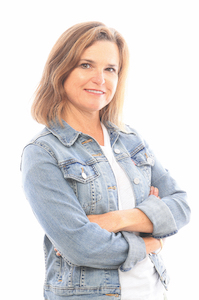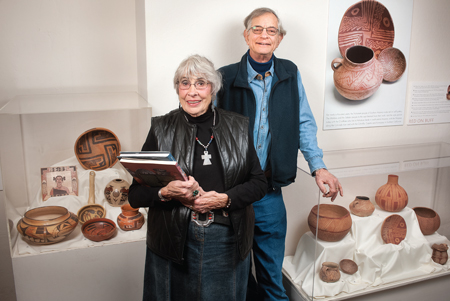Carol and Allan Hayes never expected that a weeklong trip to Santa Fe in 1989 would change their lives forever.
The plan was to find jewelry and old trade beads to sell at Carol’s small-scale general antiques business, Summerhouse Antiques. But as Allan wandered through the stores and later explored Acoma Pueblo near Albuquerque, a new fascination took hold. The couple returned home to Sausalito so enthused about the art and history of Southwestern Indian pottery, they convinced good friends John and Brenda Blom to join them the next year and then the next, as they traveled around seeking and acquiring pieces, eventually authoring three books on the topic (Southwestern Pottery, Anasazi to Zuni; Collections of Southwestern Pottery; The Desert Southwest: 4,000 Years of Life and Art). Why? Seasoned adman that he is, Allan has his “elevator pitch.”
Southwestern Indian pottery, he points out, “is unique among the world’s art forms, for three reasons. First, it’s been made by the same peoples in the same places continuously for almost 2,000 years, with the same materials and techniques. Second, it’s in a golden age right now: a creative explosion in the last 20 years has brought forth new artists with new ideas that remain true to the essential traditions. And third, it’s remarkably accessible—so much so that two Marin couples with no background in the subject could assemble a collection revealing the entire history of the art form, including examples from the most famous artists, and all by sticking to their own self-imposed spending rules (nothing over $400, with a few cheats—up to $550 tops).”
At what point did you realize that you were official collectors? It probably dates to September 1992. We all visited an archaeologist friend whom we had met at the Marin Show (the showcase of American arts held annually in San Rafael) and who lived near a prehistoric site in the Arizona mountains. She told us so much fascinating lore we were hooked.
Is collecting a business or a passion or both? As Summerhouse Antiques has evolved into a pottery specialty resource, we tell our customers that we’re collectors first and dealers second. We became dealers for two reasons: to finance more collecting and to make room in the house for more pots.
What do you do besides collecting? (Carol:) Al has spent almost his entire adult life as a writer/art director/creative director/principal in advertising agencies and marketing communications companies. That’s a major reason we started writing books. He already had the necessary skill sets. (Al:) Carol’s interest in antiques is lifelong, and as a college painting and drawing major, she got involved in the restoration of general antiques long before we discovered Native American pottery. Those restoration skills have now helped bring many mistreated pots back to a new life.
Do you have a favorite piece? (Carol:) I love them all, but I have a special weakness for the whimsical pieces from Cochiti Pueblo—funny figurines and effigies made over the last 150 years and right up to the present. I have two small collections within our collection: pottery moccasins—almost every pottery-making group made them for the tourists—and silly little bird figurines from Isleta Pueblo, made for tourists at the beginning of the 20th century. I have a whole case in our breakfast room dedicated to my peculiar treasures.
Do you have any Miwok artifacts? No. The Miwok didn’t make pottery, and we’re no pottery specialists. There’s a good reason they didn’t. Pottery is heavy and breakable; it only becomes useful when you become an agrarian culture tied year-round to the same piece of land. The Miwok moved throughout the year because the land was rich enough with game and fish to allow them to gather food year-round. Their main crafts were basketry and lithics (stone tools and artifacts).
What was the most expensive piece you ever purchased? A large jar made at Tesuque Pueblo around 1890. Aside from being beautiful to our eyes, it was extremely unusual. Most serious collectors concentrate on fine examples of the typical designs. We should point out that “expensive” here is a relative term. What seems like a major-verging-on-irresponsible stretch to us might seem like pocket change to a big-time high-end collector who gladly pays 10, 20 or even 30 times more for a choice specimen. Pots have sold for as much as a quarter of a million dollars.
What was the least expensive piece you purchased? There are several pieces that dealers felt were worthless and simply gave to us to get rid of them. Some we liked enough to put in one or another of our books. Our goal from the beginning has been to be able to study as many different types of pottery as we can, so to us, finding a minor, ignored example of a scarce, unglamorous type is a true discovery.
Have you ever considered doing archaeological digs to find pottery? We’ve walked over sites with archaeologists, and that’s enough. We have too much respect for the disciplines involved to want to play as amateurs.
Where are the best places to find pottery pieces to buy? Some people find wonderful pieces and wonderful bargains on eBay, but you’re buying sight unseen. We’ve found pottery at resale shops, antique stores and general antique shows as well as at Indian shows and stores that specialize in Indian art. Many of the best dealers are in the Santa Fe/Albuquerque and Scottsdale areas, but there are fine dealers in most metro areas.
Are people still finding prehistoric pottery? There are sites all over the Southwest, many protected on government of Indian land, but quite a few on private land, where excavation with the owner’s permission and sale accompanied by proper documentation can be legal.Think of it this way. There are as many as two archaeological sites per square mile over vast areas of Arizona and New Mexico. For more than a thousand years, the Indians built communities and lived there for up to 20 years until they’d cut down all the trees or farmed until the soil was gone or there was a forest fire, then moved on and built another one, leaving the pots behind every time they moved.
What is the oldest piece in the “1,000 years of Southwest Pottery” exhibit you curated at the Marin Museum of the American Indian in Novato? There are a few pieces in the exhibit dating from right around 1000 A.D. Most of the prehistoric pieces in the exhibit are from the museum’s collection. The museum has a few older pieces, but we only selected those that fit comfortably with the exhibit’s then-and-now theme.
Which pieces hold the most historical significance? Two come to mind. The first and most obvious is the great Gila Red Hohokam piece from around 1350 A.D. that greets you when you enter the show. When you see it, contemplate a woman who was probably about four feet tall forming it, firing it and handling it. One you’re most likely to miss is in the blackware case. During the 20th century, a potter from San Ildefonso Pueblo named Maria Martinez became world famous because of a style she invented: elegant polished blackware with matte black decoration. Next to one of Martinez’s pieces is an unprepossessing bowl from 1075 A.D. that features the same black-on-black technique. It shows there’s nothing new under the sun.
How did you get involved in the Marin Indian art show? After we’d met so many knowledgeable dealers at the Marin Show, some of whom we’d met previously on our visits to Santa Fe, we realized that the Marin Show was our best single place to find and learn about pottery. After our first book came out, we decided we had to clear out some of the pieces, so we took a booth at the Marin Show in February 1997. We’ve come back every year to what we now think of as our corner office, the booth in the far left-hand corner of the big room in the exhibit hall.
How do you respond to those who are critical of Native American art collecting? Most of the criticism is directed at people who collect prehistoric, burial or sacred materials. Almost none of the pottery falls into the sacred category. Serious ceremonial pieces are guarded by the tribes and seldom reach the marketplace. The pottery you see for sale was almost entirely made for use or for trade. Ceremonial or burial pieces comprise a tiny percentage of excavated prehistoric pottery. Unfortunately, there’s an active underground market for burial and sacred material, and criticism of this market is definitely warranted. Grave-robbing in any situation is deplorable. There are two paragraphs in Southwestern Pottery headed “why no one should ever buy a prehistoric pot” and “why we bought them anyway.” There’s also a discussion of the proper documentation you should demand before you buy a prehistoric piece. It comes down to our compulsion to expand knowledge of the art form, through books, articles, exhibits and presentations, wherever and whenever anyone will listen.
What do you plan on doing with your collection? We have a son who’s knowledgeable about and interested in our collection, and he’ll be part of any decisions about the collection’s future. For the moment, we love having the pieces around. We’re quite aware that we don’t “own” these pieces. We’re merely caretakers, seriously interested in giving them a good home and in finding good homes for the ones we don’t keep.
Tribal Arts Extravaganza!
Interested in learning more about tribal arts? Don’t leave town on February 13–14, as this weekend is billed as the largest and most trusted tribal art event in the country. The Marin Show: Art of the Americas is coinciding with the S.F. Tribal and Textile Arts show at Fort Mason. In addition to these two weekend events Arte du Monde will be happening at the Marin Center, the week prior (February 5–12). marinshow.com

Mimi Towle has been the editor of Marin Magazine for over a decade. She lived with her family in Sycamore Park and Strawberry and thoroughly enjoyed raising two daughters in the mayhem of Marin’s youth sports; soccer, swim, volleyball, ballet, hip hop, gymnastics and many many hours spent at Miwok Stables. Her community involvements include volunteering at her daughter’s schools, coaching soccer and volleyball (glorified snack mom), being on the board of both Richardson Bay Audubon Center. Currently residing on a floating home in Sausalito, she enjoys all water activity, including learning how to steer a 6-person canoe for the Tamalpais Outrigger Canoe Club. Born and raised in Hawaii, her fondness for the islands has on occasion made its way into the pages of the magazine.


